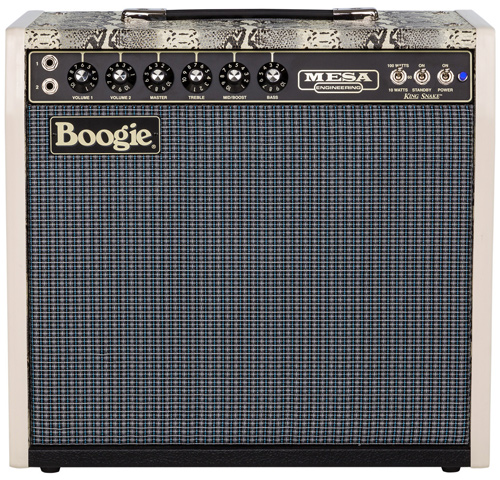When you think of Mesa/Boogie amps, two completely different sounds spring to mind: the stinging sustain of one Carlos Santana note and the super-heavy rumbling chords of your favorite metal band. By appealing to a wide swath of players, Mesa/Boogie has become a giant in the world of high-quality high-gain amps, but there’s more to the story.
Randall Smith, the founder of Mesa, built the company from a mod-shop to much-cloned tone giant, explains Doug West, the head of research and development for Mesa. And like Leo Fender and Ted McCarty, Smith does not play a stringed instrument, but that hasn’t deterred him from pushing those instruments into new and innovative places.
Early History
Smith, a lover of ham radio, started a musical instrument/repair shop in Berkeley, California in the late 1960s. Like many early amp builders, Smith started modding the amps as well. The “hot-rodding” shop achieved a following and moved to the neighboring city of Marin to be closer to the growing Bay Area music scene in the early ‘70s. The move proved successful, as Smith’s mods suited the louder and heavier music emerging from the scene.

Mesa/Boogie King Snake Combo
It was then that Mesa’s famous 100/60 watt switch was born, West says. Gear sharing was common in venues at the time, and Country Joe and the Fish wanted a way to make their amps quieter when others used them. This feature was one of the earliest power scaling features available.
Smith also made a name for himself by modding Fender amps, making small combos like the Princeton louder, higher gain and more reliable. “Randy would fix them too good. They would never break! Fender got word and threatened lawsuits,” West remembers.
Smith also began working on a pre-amp for musician Lee Michaels, which would lay the foundation for the next seminal Mesa innovation: the cascading gain stage. Taking this concept and applying it to the Fender platform, Smith had local guitar legend Carlos Santana plug into the amp he built, which was later released as the King Snake. While Santana played in the store, West recalls, “a huge crowd surrounded Santana, and he said, ‘Man, that thing really boogies!’” which led to the coining of the company’s name.
Increasing the Volume
With the demand for Mesa/Boogie amps growing, Smith needed to move out of his storefront and focus on amp building full time. West says the store had become a crazy local hangout — West was a frequent visitor as a teen — and was too distracting for the hyper-focused Smith. “It got to be a party, and Randy needed his own space,” West says.
He relocated the workshop to what is literally a plywood dog kennel, and then into his home workshop. From 1970 to 1980, Smith produced the Mark I, which refined the cascading high gain preamp.
“Randy built more than 3000 amps out of his house over those years,” West recalls. With demand still increasing, Smith moved the company to Petaluma in 1980.
Continually improving his amp concept, Smith introduced the Mark II, which was the world's first amp with a channel-changing footswitch. Players were then able to instantly change between two radically different sounds with the same amp. This amp also pioneered new concepts of channel voicings and wide EQs, as well as an effects loop. West joined the company on the Mark II C Plus model in 1981 and has worked with Smith ever since.
The Dual Rectifier Era
In 1989, Smith designed the amp that would change the face of guitar tone: The Dual Rectifier. Using silicone diodes, these amps had a sound beyond that of Fender or Marshall and had a gain level and feeling all its own. The amps grew in popularity as countless players started to notice and gravitate to the sound. What was unique about the Dual Rectifier was how players of heavy music adopted it, from metal to punk to grunge, including Metallica, Tool, Korn, Soundgarden, Foo Fighters and Blink 182. When Nu-Metal hit the music scene, the Mesa sound was deemed a requirement. “It made the company,” West says, adding that 70% of the company's sales in 2000 were solely attributable to the Dual Rectifier.
The Modern Era
Moving forward, the company has focused on making improvements rather than following trends. “Mesa wants to make an amp that grows with you and can change with your changing tastes,” West says, adding that the platform of the Mark and Rectifier Series are solid and that the company is focused on refining them with better parts and more useful features.
Mesa also makes other amp models based on the platform, such as the Trem-O-Verb, Blue Angel, Maverick and Royal Atlantic.
“We really focus on quality and improvement, not a desire to grow big,” West says, relating a time when 700 amps were unboxed to change a single resistor after Smith found a better one and requested that all of the finished amps be corrected. “Everyone in the company was in a line, pulling amps from boxes,” West says. “We might be crazy!”
While new products are in the lineup, such as the company’s recent venture into pedals, West says the company does not follow fads and no longer goes to NAMM and the new products are only released when they are as perfect as they can make them. “Word of mouth is how we grow,” West says. “We always go for magic.”
Mesa/Boogie Amps






